Trajectory based observer design: A framework for lightweight sensor fusion
IF 4.6
2区 计算机科学
Q1 AUTOMATION & CONTROL SYSTEMS
引用次数: 0
Abstract
Efficient observer design and accurate sensor fusion are key in state estimation. This work proposes an optimization-based methodology, termed Trajectory Based Optimization Design (TBOD), allowing the user to easily design observers for general nonlinear systems and multi-sensor setups. Starting from parametrized observer dynamics, the proposed method considers a finite set of pre-recorded measurement trajectories from the nominal plant and exploits them to tune the observer parameters through numerical optimization. This research hinges on the classic observer’s theory and Moving Horizon Estimators methodology. Optimization is exploited to ease the observer’s design, providing the user with a lightweight, general-purpose sensor fusion methodology. TBOD’s main characteristics are the capability to handle general sensors efficiently and in a modular way and, most importantly, its straightforward tuning procedure. The TBOD’s performance is tested on a terrestrial rover localization problem, combining IMU and ranging sensors provided by Ultra Wide Band antennas, and validated through a motion-capture system. Comparison with an Extended Kalman Filter is also provided, matching its position estimation accuracy and significantly improving in the orientation.

基于轨迹的观测器设计:轻量级传感器融合框架
有效的观测器设计和精确的传感器融合是状态估计的关键。这项工作提出了一种基于优化的方法,称为基于轨迹的优化设计(TBOD),允许用户轻松地为一般非线性系统和多传感器设置设计观测器。该方法从参数化观测器动力学出发,考虑了一组有限的预先记录的标称对象的测量轨迹,并利用它们通过数值优化来调整观测器参数。本研究以经典观察者理论和运动视界估计方法为基础。优化被用来简化观察者的设计,为用户提供一种轻量级的、通用的传感器融合方法。TBOD的主要特点是能够有效地处理通用传感器,并以模块化的方式,最重要的是,其直接的调谐过程。结合IMU和超宽带天线提供的测距传感器,在地面漫游车定位问题上对TBOD的性能进行了测试,并通过动作捕捉系统进行了验证。并与扩展卡尔曼滤波进行了比较,发现其位置估计精度与扩展卡尔曼滤波相匹配,且在方向上有明显改善。
本文章由计算机程序翻译,如有差异,请以英文原文为准。
求助全文
约1分钟内获得全文
求助全文
来源期刊

Control Engineering Practice
工程技术-工程:电子与电气
CiteScore
9.20
自引率
12.20%
发文量
183
审稿时长
44 days
期刊介绍:
Control Engineering Practice strives to meet the needs of industrial practitioners and industrially related academics and researchers. It publishes papers which illustrate the direct application of control theory and its supporting tools in all possible areas of automation. As a result, the journal only contains papers which can be considered to have made significant contributions to the application of advanced control techniques. It is normally expected that practical results should be included, but where simulation only studies are available, it is necessary to demonstrate that the simulation model is representative of a genuine application. Strictly theoretical papers will find a more appropriate home in Control Engineering Practice''s sister publication, Automatica. It is also expected that papers are innovative with respect to the state of the art and are sufficiently detailed for a reader to be able to duplicate the main results of the paper (supplementary material, including datasets, tables, code and any relevant interactive material can be made available and downloaded from the website). The benefits of the presented methods must be made very clear and the new techniques must be compared and contrasted with results obtained using existing methods. Moreover, a thorough analysis of failures that may happen in the design process and implementation can also be part of the paper.
The scope of Control Engineering Practice matches the activities of IFAC.
Papers demonstrating the contribution of automation and control in improving the performance, quality, productivity, sustainability, resource and energy efficiency, and the manageability of systems and processes for the benefit of mankind and are relevant to industrial practitioners are most welcome.
 求助内容:
求助内容: 应助结果提醒方式:
应助结果提醒方式:


